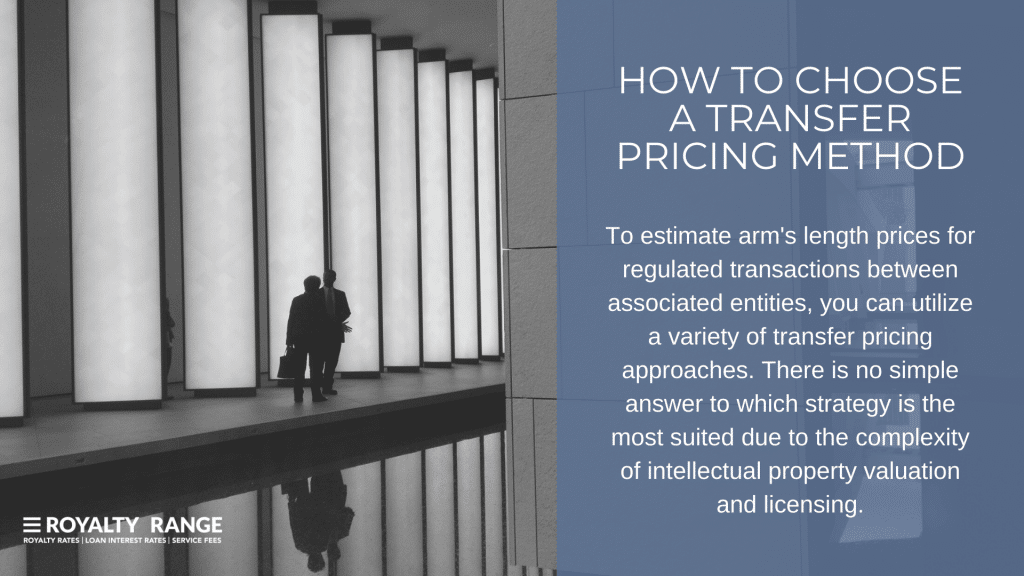How to choose a transfer pricing method

Kris (Kestutis) Rudzika |
May 15, 2021

There are a number of transfer pricing methods you can use to determine arm’s length prices for controlled transactions between associated entities. Due to the complex nature of intellectual property valuation and licensing, there is no straightforward answer to which method is most appropriate. Choosing a transfer pricing method involves analysing the most appropriate method based on the facts and circumstances of the transaction being analyzed.
What are the five main transfer pricing methods?
The Organisation for Economic Co-operation and Development (OECD) recognises five main transfer pricing methods. The five OECD-recognised transfer pricing methods can be categorised into traditional transaction methods and transactional profit methods.
The traditional transaction methods are:
- The Comparable Uncontrolled Price (CUP) Method
- The Resale Price Method
- The Cost Plus Method
The transactional profit methods are:
- The Transactional Net Margin Method (TNMM)
- The Transactional Profit Split Method
There are other transfer pricing methods, but these five are the only ones recognised by the OECD. You are allowed to use other methods to help with your transfer pricing analysis, but only if none of the OECD-recognised methods are appropriate. If you decide not to use an OECD-recognised method, you will need to provide an explanation of your reasons in your transfer pricing documentation. (If you are using an OECD-recognised method, you do not need to provide an explanation of why you chose that method over the other options.)
How do you choose a transfer pricing method?
To determine which transfer pricing method is most appropriate for your analysis, you will need to consider a number of factors in relation to the transaction that you are analyzing:
- The strengths and weaknesses of each method
- The appropriateness of the method given the nature of the controlled transaction (which you can determine through a functional analysis)
- The availability of reliable comparables data
- The level of comparability between the controlled transaction and the available comparables (as well as the reliability of any comparability adjustments needed)
It is important to remember that you need to choose the transfer pricing method that will provide the most accurate results for your analysis – not the most convenient option.
While the selection of a transfer pricing method should be focused on the individual facts of the transaction being analyzed, there are some situations where a certain transfer pricing method is preferable over others (if you have found that multiple methods are appropriate).
Is there a preferable transfer pricing method?
If you have determined that a traditional transaction method and a transactional profit method are equally appropriate for your analysis, a traditional transaction method is always preferable. This is because traditional transaction methods are considered the most direct option for establishing whether conditions in controlled transactions are at arm’s length.
Similarly, if you are choosing between the CUP method and another method (and both are equally appropriate), the CUP method is preferable. The OECD calls it “the most direct and reliable way to apply the arm’s length principle”, as long as you can find reliable comparables.
When is a transactional profit method preferable?
There are some situations in which a transactional profit method may be more appropriate than a traditional transaction method for your transfer pricing analysis. These include:
- If each party makes unique and valuable contributions to the transaction (e.g. contributes unique and valuable intangibles)
- When the functions performed, assets contributed and risks assumed are highly integrated between the parties
- Where there is no reliable gross margin data available on third parties (and no access to reliable internal comparables)
Find comparables for your transfer pricing analysis today
For a quick and easy way to find reliable comparables data for your transfer pricing analysis, try the RoyaltyRange One Search service today. Simply enter your search criteria and get a report of potentially comparable uncontrolled transactions within just a few hours.
Request One Search
We will perform the search and deliver the initial results within hours, at no cost.




